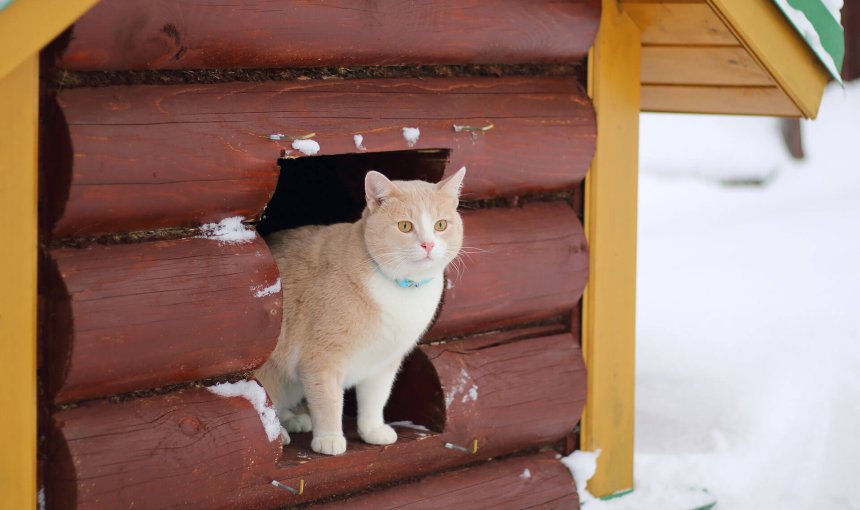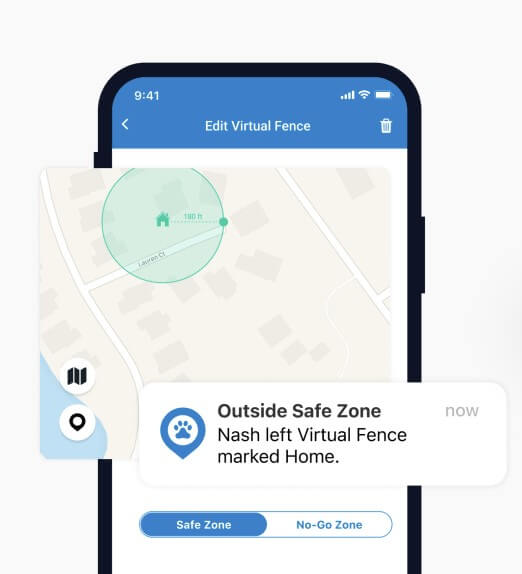How To DIY A Heated Cat House In Just 3 Steps
Looking for a fun, rewarding DIY project this snowy season? Try building a heated cat house for your outdoorsy feline buddy! Here's everything you need to know & how to find your cat if they escape their shelter.

While plenty of cats live cozily indoors, some simply prefer to stay outside. Which is where a heated cat house can be a warm, cozy, insulated space for our feline buddies when it gets cold outdoors…and they can’t get enough of the outdoors. Here are some useful tips on how to DIY your own right away, some features to consider if you’re looking to buy one, and where a GPS tracker can be an important emergency measure.

Find out where your cat spends their time.
Read moreWhy a heated shelter makes sense for an outdoor cat
If your cat likes to spend time outdoors, no matter the weather – a heated outdoor cat house can be a great option. It can provide your feline buddy a safe, cozy shelter during the winter. (Without compromising on their love to explore the outdoors.)
A cat’s normal body temperature should be around 100°F to 102.5°F (38°C to 39°C). And sometimes their fur isn’t enough for dealing with winter. Older, sick, or short-haired cats tend to be more sensitive to the cold than younger, healthier ones. And if your cat is stuck outdoors in the cold without a safe retreat, they might end up with frostbite or even hypothermia.
So as a rule of thumb, just keep in mind: if the weather is too cold for you, it is probably also too cold for your cat!
What to consider before you build or DIY a heated cat house
A good heated cat house helps provide a safe, warm, cozy space where your cat feels comfortable enough to take a nap. Here are some factors that’ll help you pick or design one your cat can’t get enough of:
Location
Place the cat heated house in a safe, underpopulated area – ideally a quiet spot your cat already likes. Cats need to feel secure and comfortable, in order to use the house. Be sure to place the shelter away from the wind and ideally against a wall or fence for a little extra warmth and stability.
Material
Whether you go for a plywood or storage bin shelter, make sure it is well insulated and waterproof.
- Plywood, heavy-duty plastic, foam boards, or Styrofoam can all be good insulating options for keeping the inside of a cat house warm in winter.
- Straw is another good alternative in this case, since it doesn’t retain moisture and keeps the inside well-insulated.
- Avoid using blankets or fabrics, these tend to trap moisture and absorb all the warmth in the interior.
Elevation
An elevated design prevents your heated cat house from getting cold, damp, snowy, or wet. Bricks, concrete blocks, or wooden pallets are simple, easy-to-install, affordable solutions.
Extra insulation
Place a support under the heated cat house, so it will not lie directly on the ground. Some simple bricks or wooden pallets can provide additional insulation to the heated cat house against potential floods or high amounts of snow.
Size
Make sure the heated cat house is the appropriate size for your cat. It should be large enough for the cat to turn around, but if it is too big, your furry little friend will have a hard time getting cozy and warm inside.
Entrance
This should be kept relatively small, so your poor cat doesn’t have to deal with any unwanted guests. (Like other cats or animals!) A door flap made of heavy plastic or thick fabric can prevent heat from escaping. Don’t forget to keep the entrance free, so your kitty is not blocked inside.
How to build your own heated cat house: A step-by-step guide
If you enjoy DIY projects, a heated outdoor cat house can be a fun, rewarding experience that’s easier to put together than you might think. Follow these steps to create a warm, cozy space for your feline buddy.
Step 1: Gather your materials
Before you get started, here are a few basic materials you’ll need:
- A sturdy plastic storage bin or plywood box to form the main structure of the house. Plastic tends to be lightweight, durable, and easy to clean. Plywood, on the other hand, might offer better natural insulation.
- Thick Styrofoam or foam boards to retain heat by lining the walls, floor, and ceilings. Most hardware stores should have these available.
- Straw for bedding, which you should place in generous layers on the floor to help your cat stay warm without trapping moisture.
- An entrance flap made of heavy-duty plastic or thick fabric for a little extra insulation and warmth.
- Optionally, a pet-safe heated pat designed for outdoor use will have your cat curling up against it all day and night.
Step 2: Build the structure
Start by lining the inside of your storage bin or box with Styrofoam. Make sure to cover all the sides, bottom, and top to trap heat inside and help your cat get cozy.
Next, add a thick layer of straw on the floor to help keep things warm.
Then, use a box cutter to create a doorway that’s big enough for your cat to wriggle through – but small enough to keep out larger animals. Attach a plastic or fabric flap over the entrance to keep the warmth inside. (If you’re making the shelter for more than one cat, a second, smaller exit can help them feel safer inside.)
Finally, elevate the finished cat house on bricks, concrete blocks, or a small wooden pallet to keep it off the ground. This prevents it from absorbing ground moisture, keeping it warmer and drier all winter.
Step 3: Add a heat source
A low-voltage heated pad that’s designed for pets can be a welcome addition if you install it at the bottom of the shelter. Go for one you can secure in place so your cat can’t bat it around and risk getting hurt. These pads provide gentle warmth, which make them great for outdoor use.
What to do if your cat escapes the shelter
Winter can be a beautiful, but dangerous, unpredictable season. And if your cat likes to roam the outdoors, there’s always the risk they’ll get caught in bad weather.
💡 Which is where a GPS tracker can be an important safety measure. Helping you track your cat’s movements – as they make their every move, in real-time – ensuring you keep them safe and sound.
For example, with your trusty Tractive device – you can set up a “safe zone” around your property perimeter, so your tracker starts monitoring your cat while they’re within it. But the moment your cat tries to leave this safe zone…

…your tracker sends you an escape alert – so you can intervene right away.
With a Tractive GPS strapped to your cat’s collar, you’ve got an extra layer of security – and that much better peace of mind you’ll always know where your cat is. Especially on freezing days or snow nights when visibility is low.
Ready to brave the snowy season in style this year?
Whether you buy or DIY, a heated cat house helps your outdoorsy cat enjoy nature – without compromising on their health or safety. Just find a quiet, comfortable spot, keep it insulated and elevated, and includes a safe exit. Your cat won’t get enough of it all winter round!
💡 And if you’re worried your cat might escape their shelter and get lost in the snow, a GPS tracker can help you track their every step – in real-time and over an unlimited range.

“Anyone with cats knows how slick they are…even if your cat is an indoor cat, they will eventually find a way out. My cat is indoor and outdoor, and I will never again have a cat without a Tractive!
First, it’s fascinating seeing where they go, their favorite spots, and the territory they establish.
Second, when she has been out too long and I start to worry, I know right where she is and I go get her! I would recommend this highly for both cats and dogs!“
– Traci, US (Source: Trustpilot)

Know everywhere your cat goes
See where they are in real-time, no matter how far they go. Get alerts if they roam too far from home. Find out where they’ve been and discover their favorite spots. Let others track with you. Track sleep and activity.
Want to see a DIY heated cat house in action? Here’s a short, sweet video covering the basics:
And if you’ve liked this post, share it with a friend or a loved one – and let’s help build a safer, kinder world for our furry friends together.




